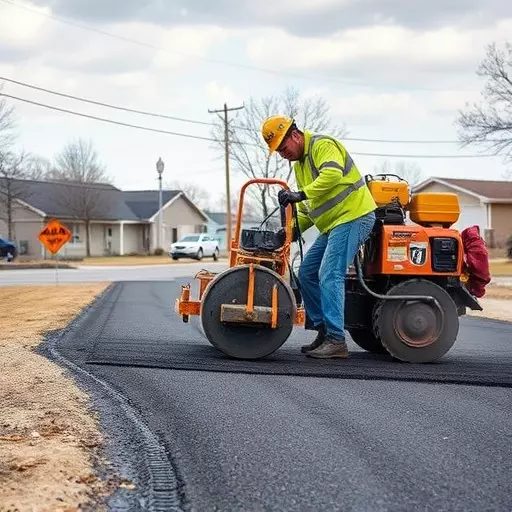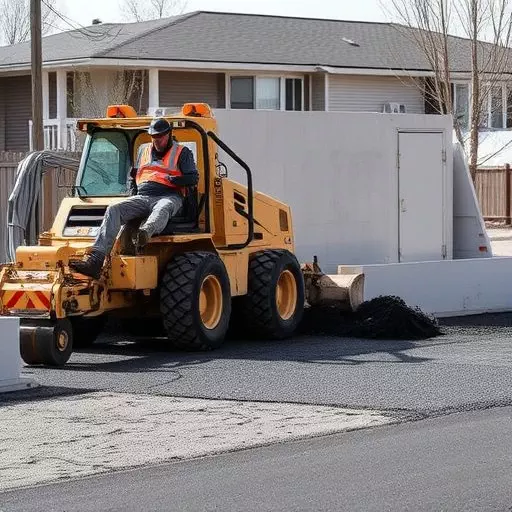Toledo's asphalt demolition contractors prioritize sustainable road maintenance using two main techniques: grinding and pavement (asphalt) milling. Pavement milling, a preferred method, involves specialized equipment to remove the top layer of asphalt while preserving the base material, offering faster completion times, reduced site disruptions, and potential for recycled asphalt reuse. While costly, it's ideal for targeted repairs. Grinding is more cost-effective for light damage but generates substantial waste and longer timelines. The choice depends on the extent and size of the project, with milling suitable for small patches and precise repair, while grinding is better for larger-scale demolitions. Both methods contribute to eco-friendly infrastructure development in Toledo.
In the realm of asphalt demolition for Toledo contractors, understanding the nuances between asphalt milling and grinding is crucial. This article delves into these key processes, highlighting their significance in efficient asphalt removal techniques. We explore how pavement milling facilitates seamless surface preparation, contrasting it with the more aggressive approach of asphalt grinding. By examining the effects on road surfaces and cost, as well as the advantages and limitations of each method, contractors in Toledo can make informed decisions to optimize their asphalt demolition projects.
- Understanding Asphalt Milling: A Key Process for Asphalt Demolition Contractors in Toledo
- The Role of Pavement Milling in Efficient Asphalt Removal Techniques
- Grinding vs. Milling: Comparing the Effects on Road Surfaces and Cost
- Advantages and Limitations of Each Method: A Comprehensive Analysis
- Choosing the Right Approach: Factors for Asphalt Demolition in Toledo to Consider
Understanding Asphalt Milling: A Key Process for Asphalt Demolition Contractors in Toledo
Asphalt milling, also known as pavement milling, is a critical process for asphalt demolition contractors in Toledo who specialize in sustainable and efficient road maintenance. This technique involves the controlled removal of an existing asphalt surface to restore the underlying base material. It’s a key service for contractors, as it allows for the reuse of recycled asphalt, reducing costs and environmental impact. By employing specialized equipment, contractors can precisely mill away the top layer of pavement while minimizing damage to the subbase.
For Toledo-based asphalt demolition contractors, understanding asphalt milling is essential for several reasons. It enables them to offer comprehensive pavement removal solutions, cater to diverse client needs, and contribute to the city’s infrastructure development in an eco-friendly manner. Whether it’s a road renovation project or preparing surfaces for new installations, efficient asphalt milling practices ensure that materials are handled responsibly, extending the lifespan of both existing and new pavements.
The Role of Pavement Milling in Efficient Asphalt Removal Techniques
Pavement milling, also known as cold planing, is a highly efficient asphalt removal technique that has gained prominence in the field of asphalt demolition contractor Toledo. This method involves the use of specialized equipment to mechanically grind and remove the top layer of asphalt pavement while minimizing damage to the base material. By employing pavement milling, contractors can effectively strip away worn-out or damaged asphalt surfaces, preparing the way for new paving projects or repairs.
Compared to traditional methods like jackhammering, which can be time-consuming and labor-intensive, pavement milling offers several advantages. It is a faster process that reduces project timelines, minimizes site disruption, and helps lower overall costs. Moreover, it ensures cleaner removal of asphalt, as it grinds the material into reusable fines, which can sometimes be recycled back into new pavements. This environmentally friendly aspect makes pavement milling an attractive option for many asphalt demolition projects in Toledo.
Grinding vs. Milling: Comparing the Effects on Road Surfaces and Cost
When it comes to maintaining and repairing road surfaces, grinding and milling are two common asphalt demolition techniques employed by contractors in Toledo. Both methods serve the purpose of removing damaged or outdated pavement layers but differ in their execution and impact on the road surface.
Grinding involves using specialized machinery with rotating abrasives to grind down the top layer of asphalt. This process leaves a smooth, uniform profile, making it ideal for preparing surfaces for new coatings or overlays. On the other hand, milling (or pavement milling) uses a cold planer to remove a specific thickness of the existing asphalt concrete. This technique is more aggressive and suitable for deeper repairs, removing not just the surface but also compacting the base material. While grinding offers a more cost-effective solution for light to moderate damage, milling is often necessary for severe cases, though it can result in higher costs due to the equipment’s specialized nature and the potential need for additional preparation and finishing steps.
Advantages and Limitations of Each Method: A Comprehensive Analysis
Advantages and Limitations Analysis
Asphalt milling involves removing the top layer of asphalt using specialized equipment while leaving a portion of the base material intact. This technique is highly effective for pavement maintenance, offering advantages such as reduced project time, minimal site disruption, and the ability to preserve and reuse the removed material for new applications. It’s particularly favored by an asphalt demolition contractor in Toledo for cost-efficient and environmentally friendly asphalt removal. Pavement milling also allows for easy access to underground utilities during the reconstruction process. However, limitations include a higher upfront cost compared to grinding, potential damage to the base layer if not executed correctly, and increased environmental impact due to material transport.
In contrast, asphalt grinding involves shredding the entire pavement surface into small particles. This method is often preferred for full-depth removal projects or when recycling the removed material is not feasible. Grinding offers advantages such as minimal site disruption, reduced noise levels during operation, and the potential to create a more uniform material for reuse or aggregate production. However, it has significant limitations. The process generates larger volumes of waste, increasing transportation costs. Additionally, grinding requires longer project timelines due to slower processing speeds compared to milling. It also necessitates careful handling to avoid contamination of recycled materials with foreign debris.
Choosing the Right Approach: Factors for Asphalt Demolition in Toledo to Consider
When it comes to pavement maintenance in Toledo, selecting the optimal approach for asphalt demolition is a crucial step. The choice between asphalt milling and grinding depends on various factors unique to each project. An experienced asphalt demolition contractor in Toledo will assess several key considerations. First, the extent of damage or wear on the existing pavement plays a significant role. Pavement milling, or surface removal, is ideal for light to moderate damage, allowing for a quick restoration without completely removing the base layers. This method is cost-effective and efficient for small-scale projects or areas with heavy traffic flow.
On the other hand, grinding is more suitable for substantial pavement deterioration or when structural repairs are required. This technique involves the complete removal of the top layer, providing an opportunity to address underlying issues. Grinding offers a more thorough solution but may be more expensive and disruptive. Additionally, the size of the project area matters. For smaller patches, milling is often preferred due to its precision and minimal site disturbance. However, for larger-scale asphalt demolition in Toledo, grinding might be more practical, ensuring efficient removal and preparation for new pavement installation.


